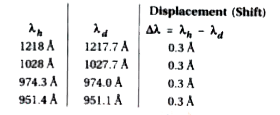The first four spectral lines in the Lyman series of a H-atom are 2=1218Å,1028Å,974.3Åand951.4Å. If instead of Hydrogen, we consider Deuterium, calculate the shift in the wavelength of these lines.Solution in Gujrati
Formula of Rydberg.s constant is R=me48ε20h2c
While deriving above formula, nucleus was assumed theoretically to have infinite mass (as compared to mass of electrons) so that it can be considered stationary at the centre of atom. But we know, in practice, all the nuclei have some definite masses. Hence Rydberg.s constant does not remain same for the atoms of different elements. Practically we find that Rydberg.s constant varies slightly for atoms of different elements. Under these circumstances, Rydberg.s constant is defined as under.
R=μe48ε20h3c...(1)
where μ= reduced mass of an electron
μ=MmeM+me where me= mass of electron
M=mass of nucleus of atom.
Note : Here, nucleus and electron become a binary system, in which both of them revolve around their common centre of mass. Such a system of two particles can be replaced by a Mme single particle of mass MmeM+me at a distance from above common centre of mass. Such a mass is called "reduced mass" of electron and it is shown by symbol μ. (Its SI unit is also kg).
Now, in formula 1λ=R(1m2−1n2) taking m = 1 for Lyman series and for its four spectral lines taking n=2,3,4,5, since here for a given spectral line, term (1m2−1n2) remains contant.
Thus 1λ∝R
orR∝1λ
But R∝μ [ From equation (1)]
∴μ∝1λ
∴μhμd=λdλh (where h for hydrogen d for deuterium)
∴λd=(μhμd)λh....(3)
⇒ Reduced mass of electron in H-atom (from equation (2))
μh=MmeM+me (Where M= mas of nucleus in H-atom =Mass of one proton =1.67×10−27kg)
∴μh=MmeM(1+meM)=me1+mem=me(1+meM)−1
∴μh=me(1−MeM)...(4) (According to binomial theorem)
Similarly, reduced mass of electron in deuteriun atom
μd=2Mme2M+me (where 2M= mass of nucleus of deuterium atom mp+mn=2mp=2×1067×10−27kg)
∴μd=2Mme2M(1+me2M)
∴μd=me2M(1+me2M)....(5)
From equation (3),(4),(5)
λd=(1−meM)(1+me2M)λh.....(6)
Now, in above equation ,
(1−meM)(1+me2M)=(1−9.1×10−311.67×10−27)×(1+9.1×10−312×1.67×10−31)
=(1−0.005449)(1+0.002724)
(0.9994551)(1.0002724)
=0.9997274...(7)
From equation (6) and (7),
λd=0.9997274λh....(8)
When we substitute four values of λh in equation (8), corresponding values of λd are obtained as follows:

Topper's Solved these Questions
- ATOMSBOOK - KUMAR PRAKASHANCHAPTER - ATOMSEXERCISE - Section-D (Multiple Choice Questions (MCQs)) (MCQs From .DARPAN Based On Textbook)
25 Videos
- ATOMSBOOK - KUMAR PRAKASHANCHAPTER - ATOMSEXERCISE - Section-D (Multiple Choice Questions (MCQs)) (MCQs From .DARPAN Based On Textbook) (Atomic Spectra)
11 Videos
- ATOMSBOOK - KUMAR PRAKASHANCHAPTER - ATOMSEXERCISE - SECTION-C (NCERT EXEMPLAR SOLUTION) ( Short Answer Type Questions)
5 Videos
- ALTERNATING CURRENTS BOOK - KUMAR PRAKASHANCHAPTER - ALTERNATING CURRENTS EXERCISE - SECTION-D MCQs (COMPETITIVE EXAMS)
64 Videos
- BOARD'S QUESTION PAPER MARCH-2020 BOOK - KUMAR PRAKASHANCHAPTER - BOARD'S QUESTION PAPER MARCH-2020 EXERCISE - PART-B SECTION -C
4 Videos
Similar Questions
According to ..... atomic model positive charge is uniformly distributed uniformly in entire volume of atom.
View SolutionWhen current is passed through gas or vapour stored at low pressure radiation of definite ...... is produced which is called radiation spectrum.
View SolutionPositronium is just like a H-atom with the proton replaced by the positively charged antiparticle of the electron (called the positron which is as massive as the electron). What would be the ground state energy of positronium?
View SolutionPower factor of AC series circuit having resistance R and inductor L having angular frequency ω is ……..
View SolutionDerive an expression for current I passing through an AC circuit containing only inductor L. Draw a Phasor diagram and graph of v and I versus ωt. Explain instantaneous power and the average power.
View SolutionThe first four spectral lines in the Lyman series of a H-atom are λ=1218Å,1028Å,974.3Åand951.4Å. If instead of Hydrogen, we consider Deuterium, calculate the shift in the wavelength of these lines.
View Solutionthe wavelength of spectral line in the lyman series of a H-atom is 1028 Å . If instead of hydrogen, we consider deuterium then shift in the wavelength of this line be (m_p=1860m_e)
View Solutionहाइड्रोजन के स्पेक्ट्रम में प्राप्त होने वाली कुछ स्पेक्ट्रमी रेखाओं की तरंगदैर्घ्य निचे दी गई हैं। इनमें से लाइमन श्रेणी की तरंगदैर्घ्य चुनिये :6560Å,1216Å,9546Å,4860Å व 1026Å.
View Solutionहाइड्रोजन परमाणु के बामर श्रेणी में प्रथम स्पेक्ट्रमी रेखा की तरंगदैर्घ्य 6561Å हैं , तब एकल आयनित हीलियम परमाणु के बामर श्रेणी की व्दितीय स्पेक्ट्रमी की तरंगदैर्घ्य होगी -
View SolutionThe wavelengths of some of the spectral lines obtained in hydrogen spectrum are 1216Å,6463Åand9546Å. Which one of these wavelengths belongs to the Paschen series ?
View SolutionThe shortest wavelength of spectral line in Lyman series is 912 Å. The shortest wavelength of the spectral line of the Paschen series is
View SolutionThe longest wavelength transitoin in one of the spectral series of hydrogen atom is 6563 Å. Identify the series to which the spectral line belongs.
View Solutionहाइड्रोजन स्पेक्ट्रम में कुछ स्पेक्ट्रमी रेखाओं के तरंगदैधर्य 9546 Å, 6463 Å तथा 1261 Å हैं | इनमें से कोण - सा तरंगदैधर्य लाइमन श्रेणी में पड़ता है ?
View SolutionThe wavelength of the first spectral line in the Balmer series of hydrogen atom is 6561 Å. The wavelength of the second spectral line in the Balmer series of singly ionized helium atom is
View SolutionThe wavelength of the first spectral line in the Balmer series of hydrogen atom is 6561 Å. The wavelength of the second spectral line in the Balmer series of singly- ionized helium atom is :
View Solution
